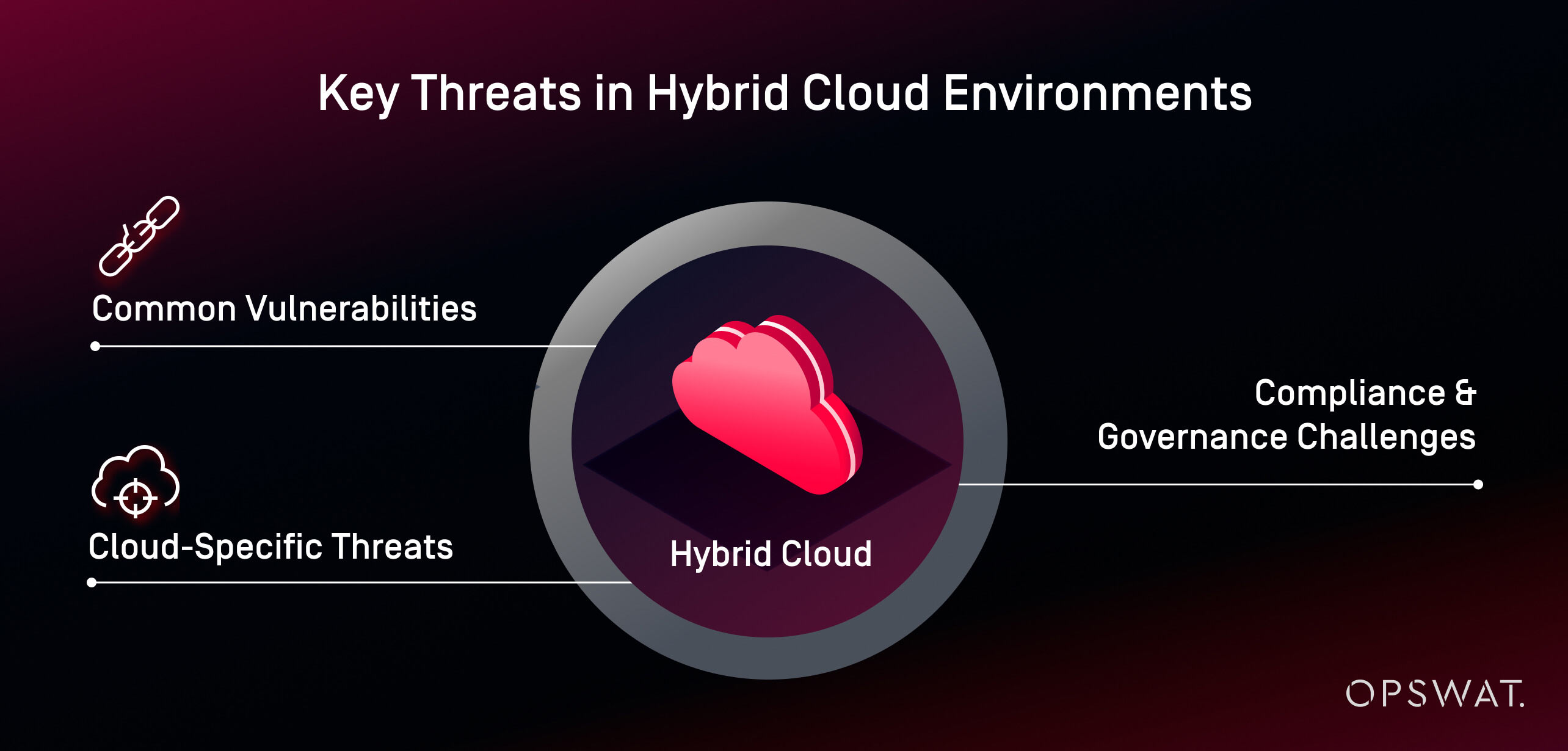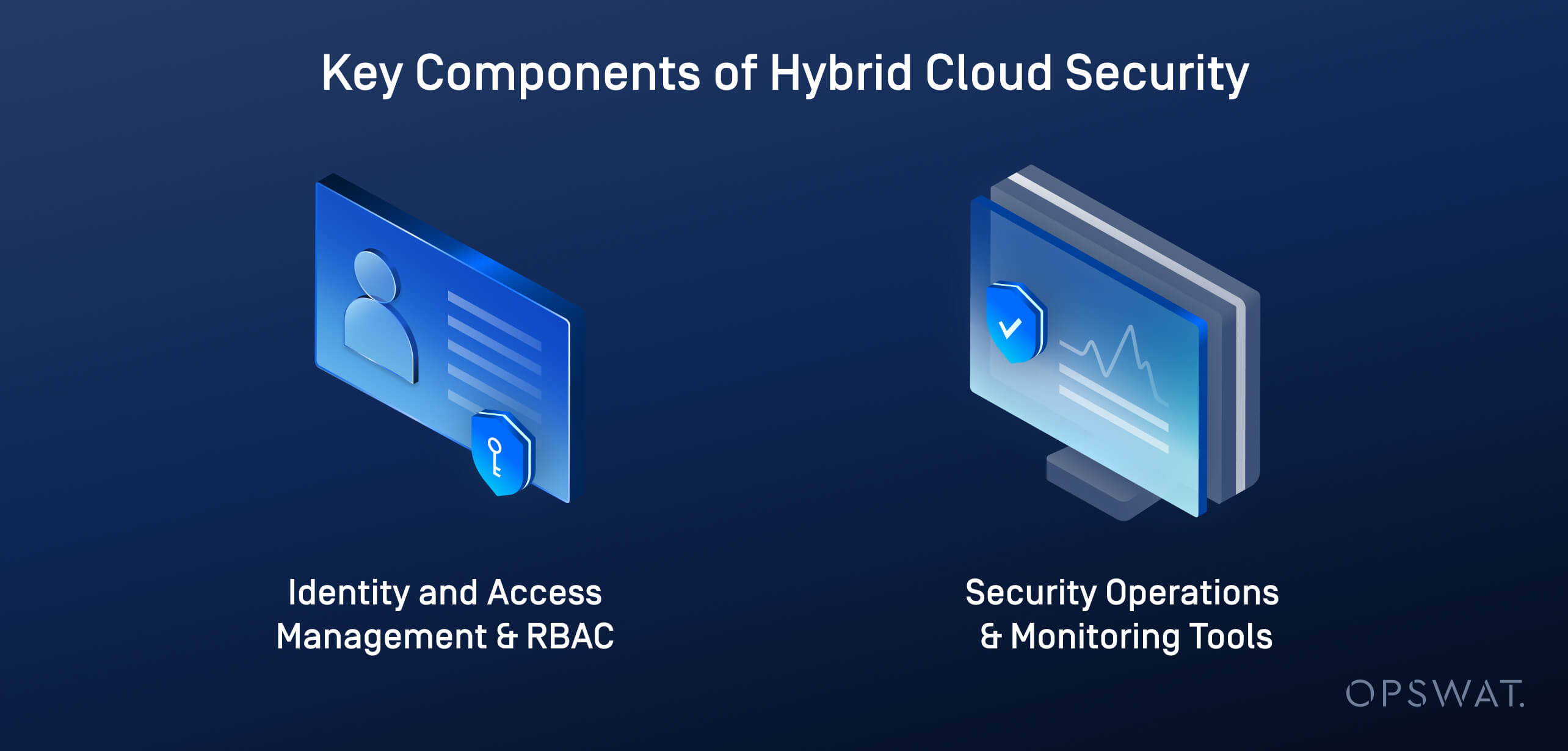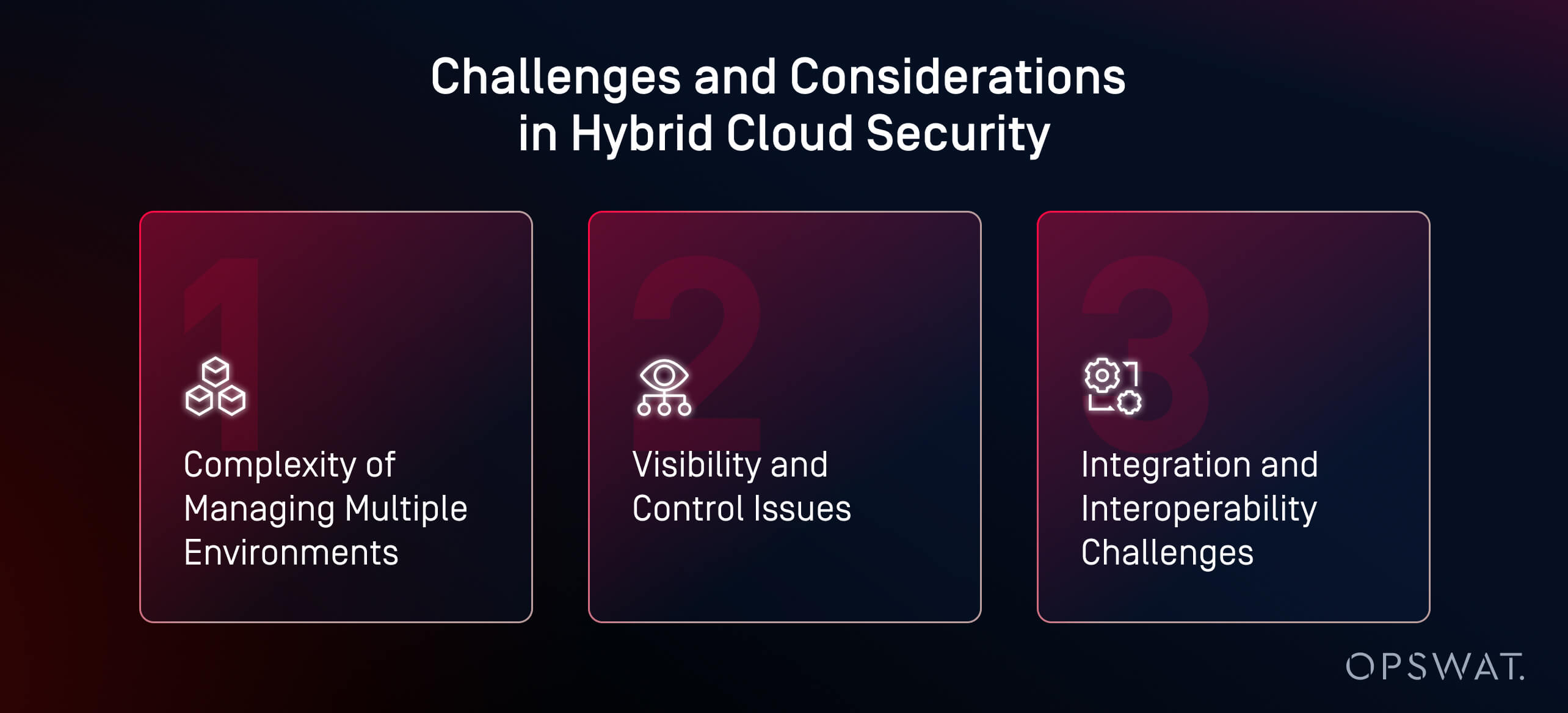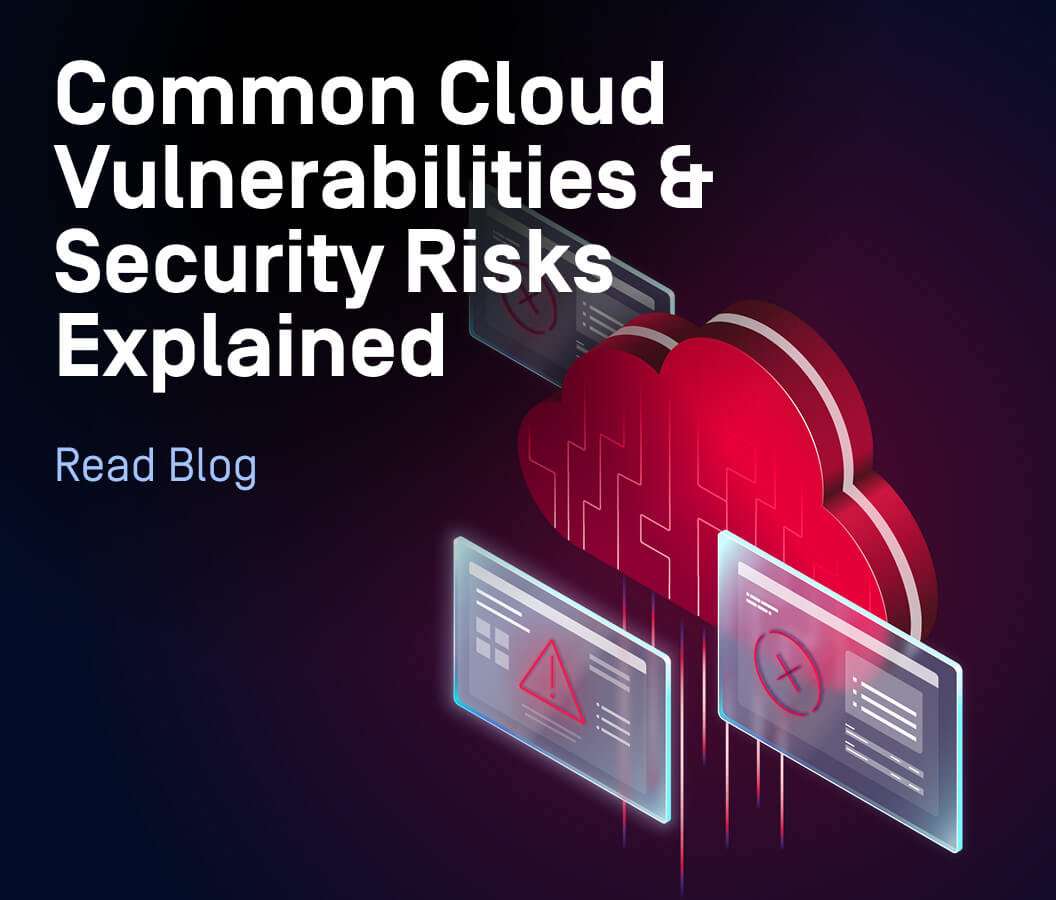- What is Hybrid Cloud Security?
- Why is Hybrid Cloud Security Important?
- Benefits of Hybrid Cloud Security
- Core Principles and Frameworks for Hybrid Cloud Security
- Key Components of Hybrid Cloud Security
- Implementation Approaches for Hybrid Cloud Security
- Challenges and Considerations in Hybrid Cloud Security
- Overcoming Hybrid Cloud Security Challenges
- Cloud-Native Protection for Hybrid Workflows — Secure Your Data Wherever It Lives
- FAQs
What is Hybrid Cloud Security?
Hybrid cloud security refers to the strategies, technologies, and operational practices designed to protect data, applications, and infrastructure across both public and private cloud environments.
This approach ensures that security controls are applied consistently, regardless of where assets reside, by integrating identity and access management (IAM), encryption, network segmentation, and continuous monitoring.
A well-architected hybrid cloud security framework helps organizations manage risk across dynamic, multi-platform environments, adapting to threats while supporting compliance and operational resilience.
In real-world hybrid deployments, organizations use one infrastructure for their primary systems and data, while the other is used for backups. In case of failure, organizations can switch between the two.
However, hybrid environments often introduce security blind spots. These can include unvalidated APIs, unauthorized deployments lacking security configurations, and misconfigurations.
While no environment is completely secure, risk can be significantly reduced. Applying proven best practices helps organizations strengthen their defenses and limit exposure.
What Is a Hybrid Cloud and Why Is It Important?
A hybrid cloud infrastructure is an environment combining on-premises environments and private clouds with public cloud services.
Hybrid environments allow organizations to run their business in a truly flexible manner, selecting what works best for each environment.
For instance, a company can use the public cloud to scale resources quickly and efficiently, but still rely on a private cloud, or on-premises infrastructure for critical processes, the ones requiring stronger security or control.
The trade-off, however, lies in security.
Hybrid cloud environments are more exposed to vulnerabilities, including risks to data in transit and data at rest.
Data in transit—such as when it's moving between clouds or between on-premises and cloud infrastructure—can be intercepted, leading to potential breaches.
Similarly, data at rest, which refers to stored data, may be susceptible to unauthorized access or failure in compliance.
Operational bottlenecks can further complicate these issues, making it crucial to address security across both states of data.
Why Is Hybrid Cloud Security Important?
Inside a hybrid cloud environment, the attack surface is larger, and a single misconfiguration or weak access policy can lead to a breach.
Even the U.S. Army Intelligence and Security has experienced data leaks caused by misconfigurations.
There’s also the pressure of regulatory compliance, when different rules apply depending on where data is stored or shared.
Finally, the split nature of hybrid setups complicates disaster recovery and failover planning, so business continuity is harder to manage.
Key Threats in Hybrid Cloud Environments
Threats in these environments come from a mix of technical gaps and human oversight.
The rapid shift to remote work and cloud infrastructure following COVID-19 only intensified these risks, as many organizations made the transition without fully developed security frameworks.
To properly mitigate these challenges, we must first understand the issues.

Common Vulnerabilities
Misconfiguration remains one of the most common issues in the cloud, manifesting through improperly set access controls, exposed storage, or outdated components.
Another serious concern is lateral movement after a breach; once attackers penetrate your infrastructure, they can move across systems, searching for sensitive assets.
The hybrid model, which spans multiple platforms, makes this kind of activity harder to detect and block.
Finally, insider threats also present a real risk, especially when permissions are not tightly managed.
Cloud-Specific Threats
Cloud-specific threats like malware, ransomware, and data breaches hit harder in hybrid environments, where data constantly moves between on-prem systems and cloud platforms.
This movement widens the attack surface, giving adversaries more opportunities to slip undetected.
Ransomware groups now use AI-driven tools to bypass standard defenses, while data breaches grow more damaging.
Weaponized file uploads have also become a rising threat in hybrid cloud setups.
Malicious actors often embed malware in seemingly innocent files to bypass security filters and deliver payloads undetected.
Technologies like Deep CDR (Content Disarm and Reconstruction) can neutralize these threats by stripping out malicious code from files before they can cause any damage.
Hybrid setups can also blur the lines of responsibility, leading to weak points in access controls or patching.
Compliance and Governance Challenges
The platforms inside a hybrid setup can be governed by different laws about where data should be stored and how it should be handled.
1. Rapid Adoption Post-COVID
The growth in hybrid cloud adoption, accelerated by the COVID-19 pandemic, has made security more critical than ever.
Organizations rapidly moved to remote work and cloud infrastructure, but many did not have adequate security frameworks in place for such a distributed, multi-platform environment. This increase in cloud adoption creates more entry points for attackers and complicates compliance management.
2. Regulatory Complexity
In such a diverse system, it’s overwhelming to align your processes with regulatory requirements like GDPR, which mandates that certain data must reside within the EU.
3. Auditability in Hybrid Systems
It’s also challenging to audit data access and movement, since traditional tools may not work effectively across hybrid setups.
Benefits of Hybrid Cloud Security
All risks considered, hybrid cloud security still offers a strong mix of advantages, especially when compared to single-cloud or on-premises systems.
Flexibility and Scalability
Hybrid environments enable organizations to secure sensitive data in private clouds or on-prem systems while using the public cloud for less critical operations.
This allows SOC teams to respond to changing security needs without compromising protection.
Risk Management
Hybrid cloud setups reduce the chance of a single point of failure, which occurs when one critical component failure causes the entire infrastructure to collapse.
When data is distributed across multiple environments, a breach in one area doesn’t put the entire infrastructure at risk.
Compliance and Continuity
The hybrid environment also supports better compliance, allowing businesses to store sensitive data where necessary for regulatory reasons, while using other platforms for more general workloads.
For example, if one environment faces issues, businesses can quickly transition to others, minimizing downtime.
Hybrid Cloud Security vs. Public and Private Cloud Security
While there’s no perfect cybersecurity framework, one created in a hybrid environment stands out through its ability to support more flexible protection strategies compared to public or private cloud models.
The possibility to maintain both legacy tools and modern cloud-based defenses within the same setup allows for a layered approach that matches the risk level of each environment.
If a vulnerability affects one platform—such as a supply chain issue tied to a public provider—teams can shift operations elsewhere to contain the risk.
Hybrid systems also draw security data from a wider range of sources, improving how threats are detected and handled.
This approach gives organizations more room to adjust, isolate issues quickly, and keep security decisions closer to their needs.
Core Principles and Frameworks for Hybrid Cloud Security
Some foundational key principles for hybrid cloud security include Zero Trust security, which ensures that no entity is trusted by default and supply chain security considerations.
The latter are focused on safeguarding dependencies and third-party software.
Cloud Security Frameworks and Standards
(CCM) Cloud Controls Matrix
To organize security practices, many teams apply the (CCM) Cloud Controls Matrix from the Cloud Security Alliance.
The CCM breaks down cloud-specific control domains—like identity management, infrastructure security, and compliance—and aligns them with global standards such as ISO and NIST.
It also helps define roles and responsibilities across IaaS, PaaS, and SaaS service models, which is especially helpful in hybrid setups.
(CSPM) Cloud Security Posture Management
CSPM tools address the risk of human error - the leading causes of security issues – by finding and correcting misconfigurations.
Zero Trust and Supply Chain Security in Hybrid Cloud
One widely used approach in cybersecurity is Zero Trust.
This assumes no default trust for any user, device, or application. Access is granted based on identity, context, and real-time checks, not location or network.
Solutions like MetaDefender Cloud embed Zero Trust principles through proactive file inspection and threat prevention across multi-cloud workflows.
Hybrid architectures rely on external services such as APIs, managed platforms, and open-source tools, so protecting the software supply chain is also on top of SOCs minds.
Key Components of Hybrid Cloud Security
The hybrid cloud is both a powerful enabler and a uniquely risky environment.
In this context, a hybrid cloud security framework requires a distinct, multifaced approach, with a couple key elements.

(IAM) Identity and Access Management and RBAC
IAM represents an access control framework, which ensures that only the right individuals access the right resources at the right times for the right reasons.
IAM is central to hybrid environments where identities span across on-prem and multiple cloud services.
In the IAM framework, two methods are highly effective:
- (RBAC) Role-Based Access Control
- (PAM) Privileged Access Management
Role-Based Access Control
RBAC assigns permissions based on a user’s role in an organization, limiting what data and actions they can access or perform. Roles are typically based on job functions (e.g., developer, analyst, HR), and each role has a predefined set of access rights.
This method enforces the principle of least privilege, ensuring users only get access to what they need. It also helps with governance and compliance by structuring access logically.
Privileged Access Management
As opposed to RBAC, which only assigns permissions based on job functions, PAM is used to secure and manage access to privileged accounts, namely those with administrative rights or access to critical systems.
In a hybrid setup, PAM is critical for securing infrastructure management layers (e.g., domain controllers, cloud admin portals) and controlling access to cloud management consoles (e.g., AWS root, Azure global admin).
Security Operations and Monitoring Tools
(SOC) Security Operations Center
A SOC is a centralized unit that monitors, detects, responds to, and mitigates security threats.
This unit uses people, processes, and technology to coordinate threat detection and response with round-the-clock monitoring.
(CASB) Cloud Access Security Broker
The CASB is a security policy enforcement point between cloud service consumers (organizations) and providers.
Within the CASB, organizations are responsible for what they upload and how they interact with the cloud, even if they don’t run the infrastructure.
CASBs help detect and manage Shadow IT, data movement, and user behavior, giving IT visibility to unauthorized tools being used.
For the hybrid infrastructure, CASBs allow unified governance. This way, on-prem security and compliance aren’t compromised when data is moved to the cloud.
(SIEM) Security Information and Event Management
SIEM is a platform that collects, aggregates, analyzes, and correlates security data to detect threats and produce real-time alerts.
It centralizes log and event data from on-premises and cloud systems, for consistent threat detection. It also provides situational awareness, forensic insights, and compliance reporting.
SIEM can be integrated within a cybersecurity solution, as is the case with the MetaDefender Cloud and Splunk SIEM integration.
Implementation Approaches for Hybrid Cloud Security
In the hybrid setup, security architects need a set of tools, practices, and policies which can be implemented seamlessly across cloud and on-prem systems.
(CSPM) Cloud Security Posture Management
CSPM are tools which automatically assess and manage cloud configurations. Their purpose is to detect misconfigurations, compliance violations, and risky settings across cloud environments.
They’re especially useful for hybrid clouds, as these setups are dynamic and complex, with frequent changes across public cloud and on-prem environments.
Continuous Monitoring and Incident Response
More of a process than a tool, this refers to the ongoing collection and analysis of logs, metrics, and security events to detect threats.
For it to work, monitoring needs to be coupled with a defined process for investigating and responding to incidents.
In a hybrid environment, this process provides a unified threat view over scattered devices or software such as cloud-native apps, SaaS, on-prem firewalls, servers, and endpoints.
Automated Policy Enforcement
Finally, we have the use of tools and scripts to enforce security policies automatically. These policies can mean disabling non-compliant resources, enforcing encryption, or blocking unapproved services.
Automated enforcement ensures security rules travel with the workload, regardless of whether it lands.
Best Practices for Managing Hybrid Cloud Security
Besides all tools and policies, the hybrid cloud security framework is also built on operational tactics such as:
Security Monitoring and Alerting
In a hybrid model, threats can originate in the cloud and impact on-prem (and vice versa).
Real-time or near-real-time surveillance of systems and services will detect and expose any malicious behavior, before any harm crosses the threshold.
Incident Response and Forensics
Effective incident response limits business disruption, while forensics preserves evidence, and improves future defenses.
Response Automation and Playbooks
These are predefined workflows and scripts that automate parts of the incident response process — like isolating a host, disabling a user, or blocking an IP.
If an incident spreads across the environment, automated actions can contain threats faster than human teams.
Challenges and Considerations in Hybrid Cloud Security
When it comes to protecting a hybrid cloud infrastructure, the challenge is less in the technologies used, as it is in coordination and consistency across all environments.

Complexity of Managing Multiple Environments
By its nature, a hybrid cloud infrastructure is governed by multiple tools, policies, and controls.
This forces security teams to use multiple platforms, which increases the risk of misconfiguration.
Moreover, if one system changes, it doesn’t automatically sync with the others. This leads to more risks of oversights.
Visibility and Control Issues
The diverse nature of the hybrid setup also leads to a lack of consistent insight into who is accessing what, where data resides, and how resources are configured across all environments.
Scattered data can hide critical risks.
Integration and Interoperability Challenges
On-premises and cloud infrastructures aren’t necessarily built to communicate with each other. This creates a challenge when it comes to connecting security tools, identity systems, and policies across environments.
APIs, log formats, and access models vary widely between platforms, and legacy systems on-prem may not support modern authentication.
Overcoming Hybrid Cloud Security Challenges
Addressing these challenges requires strategies aimed at strategically managing complexity, reducing attack surfaces, and ensuring consistent controls across on-premises and cloud environments.
Unified Security Policies
The idea is to create a shared set of rules across all environments, thus avoiding getting tangled in the complexity of each setup.
Organizations can deploy one identity system to manage who can log in and what they can access.
Tools like Azure AD or Okta support single sign-on and multi-factor authentication.
Another idea is to build policy templates for repeatable needs like password rules, network rules, and encryption requirements.
Finally, all security policies need to match outside standards like GDPR, HIPAA, or ISO 27001 to stay ready for audits.
Centralized Monitoring and Management
If each team looks at different data in different tools, attacks may go unnoticed.
To avoid blind spots, organizations should collect logs and alerts into one place using SIEM or SOAR tools, while using endpoint tools that work across systems.
It will also help if teams have a single dashboard that shows important alerts across all systems. This helps security professionals respond faster and spot patterns.
Vendor and Supply Chain Risk Management
When each new system introduces a new point of failure, a single weakness can affect your data.
Fortunately, you can review every third-party service through standard methods like ISO 27036 or NIST 800-161.
Even if the tool passes certifications and becomes part of your network, you shouldn’t assume it’s safe. Limit what each one can do and monitor everything.
At the beginning of each partnership, write contracts that require security steps and clear rules for what happens if something goes wrong.
Finally, use API gateways, firewalls, and network rules to keep outside systems in their own space.
Cloud-Native Protection for Hybrid Workflows — Secure Your Data Wherever It Lives
The hybrid cloud infrastructure needs to be protected by innovative, scalable, and flexible solutions.
OPSWAT’s MetaDefender Cloud™ is built for exactly that.
This SaaS-native solution combines advanced threat detection, Deep CDRTM, proactive DLP, and sandboxing to detect, neutralize, and analyze known and unknown threats across all file types.
MetaDefender Cloud can inspect 20+ file types, enforce customizable policies and integrate into workflows across AWS, Azure, and beyond.
Explore how MetaDefender Cloud can simplify hybrid cloud security while keeping your data safe, wherever it lives.
Frequently Asked Questions (FAQs)
Q: How do you manage security in a hybrid cloud environment?
In hybrid cloud environments, security is through a combination of access controls, encryption, continuous monitoring, and identity management. It’s crucial to integrate security tools across both on-premises and cloud systems to ensure visibility and control, while automating threat detection and response.
Q: What is a hybrid approach in cyber security?
The hybrid approach in cybersecurity combines on-premises and cloud-based security solutions. This approach protects private and public cloud environments, while offering flexibility and scalability without compromising security for sensitive data and systems.
Q: What are the challenges of hybrid cloud security?
Challenges include managing visibility and control across multiple platforms, ensuring data protection during transfer, complying with regulations, preventing misconfigurations, and addressing cyberthreats. It’s difficult to maintain consistent security policies across all environments.
Q: What is a hybrid security model?
A hybrid security model uses combined security approaches, such as on-premises, cloud-based, and third-party solutions to protect data and systems across diverse environments. It allows organizations to customize security controls to their specific infrastructure.
Q: How does Deep CDR support hybrid cloud security?
Deep CDR sanitizes files at every entry point and removes threats without impacting usability. It integrates seamlessly across both on-prem and cloud-based environments, ensuring consistent protection regardless of where files originate or are accessed.

